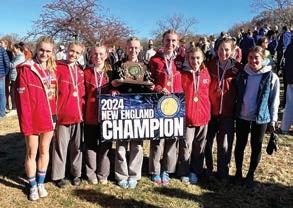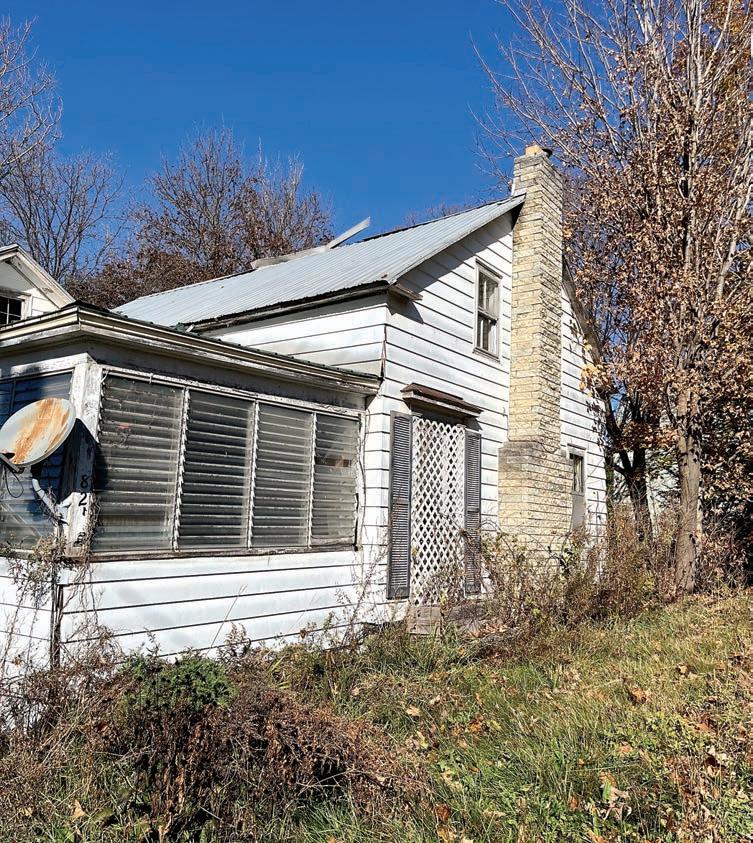








LIBERTY DARR STAFF WRITER
After months of backlash, the Charlotte Selectboard is now mulling whether to reverse a decision that lowered speeds on a portion of Ferry Road to 25 mph.
At a selectboard meeting last week, a dozen residents took to the mic to voice both concern and support for the speed change. But this is far from the first time that speed has been a topic of conten-
tion in town.
Historically, residents have brought concerns to the selectboard regarding speeding in certain parts of town and have urged the selectboard to act, from implementing traffic calming solutions to intensive speed studies.
Two years ago, the issue peaked when three dozen residents along Greenbush Road filed a
PATRICK BILOW STAFF WRITER
Green Mountain Habitat for Humanity is just days away from applying to build homes in Hinesburg.
Earlier this year, the regional arm of the international nonprofit purchased a lot at 827 Mechanicsville Road intending to build affordable homes.
Since then, a team of local
volunteers has been drafting plans that will be submitted to the Hinesburg Development Review Board within the month.
An abandoned single-family home currently on the property is set to be demolished to make way for six new housing units, according to Robin Pierce, real estate and development construction manag-
See SPEED on page 10 See HOMES on page 16

Blizzard of Oz. Slush Puppy. It’s Snow Problem. Gerald. Coldy. Ski Buddy.
Those are some of the 118 new names that the Vermont Agency of Transportation received for its big orange plow trucks through this year’s Name a Plow program for Vermont schools.
The agency also received 77 entries in the contest for schools to name a new plow truck that has a second plow spanning 21 feet and which will be used to clear Interstate 89. That truck is now named “The Vermonster” thanks to the winning entry from Townshend Elementary School.
“Vermont students have had a
lot of fun naming our plow trucks, and we love seeing what they come up with,” transportation secretary Joe Flynn said. “The names create a connection between the communities and our hard-working plow operators, and the program is also a great way for us to talk with young Vermonters about the importance of winter highway safety and the work our teams do to keep the roads well maintained and safe.”
The Name a Plow program began in 2021, when Vermont schools named 163 of the state’s 250 full-sized plow trucks.
The new 2024 plow names will replace the old names for all schools that participated in the
past and again this year. Plow trucks that were named previously by schools that did not send a new name this year will keep their current names.
Here are some local participants and their plow names:
• Gertrude Chamberlin School, South Burlington, Slush Puppy
• Rick Marcotte Central School, South Burlington, Gerald
• Shelburne Nursery School, Coldy
• Vermont Commons School, Shelburne, Shell Shocked
For a complete list of plow names, go to vtrans.vermont.gov/ name-a-plow.
Lee Krohn of Charlotte was honored as Planner Emeritus by the New England Chapter of the American Planning Association at its annual conference last week in Stowe.
The chapter’s new Planner Emeritus award recognizes professional planners who have dedicated 30 or more years of service to the planning profession and to the communities, organizations and people they have served.
Krohn began his service as a volunteer member and then chair of the Putney Planning Commission in the 1980s. He then began a 25-year run as planning director in Manchester, where at various times he also served as zoning administrator, tree warden, service officer, interim town manager and as construction manager for the town’s roundabout and Main Street reconstruction project.
He was a successful grant writer for many different projects, not least of which was the award-winning “un-development” of a former auto dealership in the heart of the downtown into a town green.
Krohn then worked from 2013-2018 as a senior planner for the Chittenden County Regional Planning Commission, where he helped with many local and regional initiatives, including a focus on emergency management planning and response.

More recently, he served as Shelburne town manager from 2018-2023, a position that included personnel, budgets, equipment and infrastructure upgrades and replacements, and overseeing the construction of the new Pierson Library, all the while maintaining focus on long-range planning projects like the Irish Hill bike and pedestrian path and bridge. He also served on the Manchester Volunteer Fire Department and when he moved north joined the Shelburne Fire Department, where he has continued to serve since 2014. He lives in Charlotte with his wife, Carol Talley, MD.
He is a member of the American Institute of Certified Planners.


ISSUE DATE: Wednesday, Nov. 27
BANG and Combo Ads
DEADLINE: Thursday, Nov. 21, 5 p.m.
Display and Classified Ads
DEADLINE: Friday, Nov. 22, Noon
Editorial Submissions
DEADLINE: Friday, Nov. 22, Noon
“It has been an honor and a privilege to serve these communities in so many ways. While many may aspire to higher calling in state or federal agencies, I have always found both the challenge and the magic is really at the local level, where one can have a truly tangible impact and help to leave this world a better place than we found it,” Krohn said.
Fire department coat, gear giveaway this weekend
The Hinesburg Fire Department Winter Coat and Gear Giveaway is Saturday, Nov. 16, 9 a.m.noon at the Hinesburg Fire Station.
There will be a large selection of coats, jackets, snow pants, in sizes from kids to XL adults. And it’s all free.
PATRICK BILOW & LIBERTY DARR STAFF WRITERS
With Charlotte’s town planner set for retirement in less than a month, the town is exploring a potential agreement for shared planning services with the neighboring town of Shelburne.
Meanwhile, some leaders in Shelburne are beginning a conversation with neighbors about the concept of regionalizing services on a larger scale.
While the state — with the passage of S.159 in May — is beginning the long work of studying how to best strengthen county-level government in Vermont, which has long held the tradition of hyper-local control, some municipal leaders have taken measures into their own hands.
According to Shelburne and Charlotte, the shared service concept for planning is in its very early stage, but there is an eager appetite in both towns to see how something like that could flesh out.
“I have seen shared service agreements work in other towns and other settings and thought to myself that this could be mutually beneficial for the town of Shelburne and town of Charlotte,” Charlotte’s town administrator, Nate Bareham, said.
The Charlotte Selectboard discussed the matter during an executive session at last week’s meeting, but nothing has been finalized. Bareham said he hopes to bring a proposal to the selectboard prior to Dec. 1.
Matt Lawless, town manager of Shelburne, noted that such a collaboration is not only in the spirit of neighbors helping neighbors but also regional efficiency. It could also go a long way to help Vermont towns save money.
“We have a great planning staff,” Lawless said. “I think that’s a good idea for a number of our skilled staff. We’ve got a diesel mechanic who could go over to another town and fix a truck, and I like the idea of setting up that kind of contract.”
While every town has certain legal obligations to do a little bit of planning and zoning work, Lawless said, for many towns that work oftentimes doesn’t require 40 hours a week.
“You can’t hire a 17-hour professional planner, so maybe we can share,” he said.
Bareham noted that like many other communities in the state, Charlotte is not getting as much
traffic coming in and out of the planning and zoning office recently. While there is always the option to hire an outside consultant, they can often cost significantly more. Since the towns are close in proximity, there is room for shared problem solving, especially as planning issues may cross town boundaries.
“There’s also a benefit in the fact that we’re neighboring towns, and so we share a lot of the same interests and have a lot of the same concerns,” Bareham said. “The idea that we could have somebody come in who’s already relatively familiar with the area, knows a lot of the key players, that’s all of great benefit to us.”
He also noted that the shared service agreement would limit other time-consuming processes like training and bringing on a new staffer.
Matt Wormser, vice-chair of the Shelburne Selectboard, has long been a proponent of regionalizing services on the municipal level.
Over the last few monhts, he’s been meeting with neighboring towns to discuss possible relationships.
He noted last week that the same service gaps that drove the passage of Act 46 — the 2015 law that led to the consolidation of 206 school districts to the 50 seen today — exist on the municipal level.
Meanwhile, the cost of municipal services is rising due to increased health care costs and other factors. That expense is passed on to taxpayers through increased property tax rates, which outpace inflation yearly in some Vermont towns like Shelburne.
Wormser believes that regionalizing some services would fill those gaps, creating more efficient and reliable departments, while also bringing down costs and, therefore, property taxes.
“We bleed like stuck pigs in Vermont for local control,” said Wormser, “but I don’t think people actually care about local control for two-thirds of the services we provide. They might want to see ‘Shelburne’ on the side of a police car, and I get that, but there’s a lot more going on behind the scenes.”
Administration is one example of a behind-the-scenes service that could be made more efficient through regionalization.
Wormser said department heads are frequently bogged down by administrative work, such as
hiring or training. This is especially prevalent with law enforcement and fire and rescue services.
Regionalization, Wormser said, would create a bigger organization with more revenue, opening the opportunity to hire a dedicated administrative person who could support department heads.
He said it would be more cost-effective, for example, to train 20 firefighters for a region, rather than three or four for each town.
Wormser is also taking a close look at Shelburne’s dispatch service, and during a selectboard meeting last month, he asked his fellow board members to help create a more cost-effective department.
Shelburne already manages a regional dispatch service for 32 towns in northwest Vermont, which brings in substantial revenue for the town, but there are still inefficiencies to overcome with the model.
As it currently stands, Shelburne fronts most of the dispatch cost while only accounting for about 20 percent of dispatch calls. A major goal for Wormser is leveling the cost structure, an important factor to keep in mind as the discussion of regionalization continues.
“If we’re going to provide services for another community, then compensation needs to be proportionate to the service we’re providing,” Wormser said.
Wormser has also touted the need for better municipal technology for IT and finance departments since joining the selectboard. He said that Shelburne is exploring upgrades, but he’s regularly petitioned the state to lead that charge.
“We’re hamstrung in small communities to find better tech that can drive efficiency, but given the size of our state, there are some things that would just make more sense for the state to run,” Wormser said. “This stuff is expensive and there’s no real value in local control over a web server.”
While nothing is set in stone — Wormser is merely trying to “play ball with communities who want to play ball” — there are two models for regionalization, according to the selectboard member.
The quickest model involves a contract between municipalities for a specific service.
An example is the contract





Total reported incidents: 47
Arrests: 4
Oct. 29 at 4:54 p.m., an officer investigated a motor vehicle crash that was reported after the incident occurred.
Oct. 30 at 8:07 a.m., someone on Observatory Road reported a theft. An officer investigated.
Oct. 30 at 1:17 p.m., someone reported an abandoned vehicle on Hillview Terrace. Upon investigation, officers found that it had been stolen in Burlington.
Oct. 30 at 4 p.m., officers investigated a report of a vehicle that was stolen from Major Street.
Oct. 31 at 11:04 a.m., officers assisted Vermont Alcohol, Tobacco, Firearms and Explosives with an arrest warrant on North Road.
Nov. 2 at 10:25 a.m., an officer investigated a traffic hazard on Shelburne Falls Road.
Nov. 2 at 2:28 p.m., someone submitted a vehicle complaint on CVU Road.
Nov. 3 at 1:45 p.m., someone reported suspicious activity on Silver Street.
Nov. 4 at 5:34 p.m., someone reported abandoned property on Ballad’s Corner Road. An officer investigated.
Nov. 5 at 7:00 a.m., officers investigated a report of trespass and destruction of property on Magee Hill Road.
Nov. 5 at 6:05 p.m., a driver hit a
deer on Silver Street.
Nov. 5 at 9:11 p.m., officers responded to a domestic dispute on Silver Street. Sean Lang, 48 or Hinesburg, was arrested for aggravated domestic assault.
Nov. 6 at 7:37 a.m., an officer investigated a report of theft on Texas Hill Road.
Nov. 6 at 10:05 a.m., someone reported suspicious activity at Champlain Valley Union High School.
Nov. 6 at 2:22 p.m., an officer responded to a domestic dispute on Charlotte Road.
Nov. 6 at 3:35 p.m., officers investigated a vehicle theft on Birchwood Drive.
Nov. 6 at 5:30 p.m., after investigating suspicious activity on Fern Road, police arrested Sara Whritenour, 37 of Hinesburg, for operating without owner’s consent, driving with a criminally suspended license, driving without an ignition interlock device, unlawful trespass and providing false information to a law enforcement officer.
Nov. 7 at 8:18 a.m., Lucas Wedin, 23 of Hinesburg, was arrested for stealing a recreational vehicle on Ledgewood Lane. He was charged with grand larceny, operation without the owner’s consent and unlawful trespass.
Nov. 9 at 10:10 a.m., a theft was reported on Magee Hill Road.
Nov. 11 at 3:48 p.m., officers investigated a retail theft a Kinney Drugs.
Serving the community of Charlotte & Hinesburg A publication of Vermont Community Newspaper Group LLC thecitizenvt.com
Advertising Wendy Ewing wendy@shelburnenews.com (802) 985-3091 x12
Advertising Director Judy Kearns judy@otherpapersbvt.com (802) 864-6670 x21
News Editor Tommy Gardner
Staff Writers
Aaron Calvin Liberty Darr Patrick Bilow
Production Manager Stephanie Manning stephanie@shelburnenews.com
Editor/Publisher Gregory Popa gpopa@stowereporter.com
Billing inquiries Leslie Lafountain leslie@stowereporter.com (802) 253-2101
Advertising submission deadline: Friday at 5 p.m. advertising@thecitizenvt.com classifieds@thecitizenvt.com
Editorial submission deadline: Friday at 5 p.m. news@thecitizenvt.com
Calendar submission deadline: Friday at 12 p.m. news@thecitizenvt.com
Contact: 1340 Williston Road South Burlington, VT 05403 (802) 985-3091
MIKE DONOGHUE CORRESPONDENT
A Hinesburg man, who authorities say was caught with illegal possession of firearms twice in unrelated incidents in recent weeks, has been ordered jailed pending federal trial.
Anthony Seagroves, 32, was found with a loaded privately made firearm — also known as a ghost gun — on Oct. 14 in downtown Burlington, the Bureau of Alcohol, Tobacco, Firearms and Explosives said.
Seagroves was one of three people slumped over inside a running car parked behind the Fletcher Free Library on College Street in Burlington. City officers learned that the vehicle had been reported stolen from South Burlington. Seagroves was behind the wheel, police said.
Hinesburg police said they caught Seagroves with a gun after officers were asked to investigate a second stolen car on Oct. 23. He faces state charges in that case.
In U.S. District Court Nov. 2, attorney Barclay Johnson said the defense would not contest Seagroves’ detention.
The ATF said Seagroves is prohibited from possessing firearms and ammunition because of his criminal record, which includes a May 2019 felony conviction for burglary in Chittenden County. He has six other felony arrests, but prosecutors have either dismissed the charges or lowered them to misdemeanors, records showed.
He also has eight convictions among his 15 misdemeanor arrests and seven cases of failure to appear in court.
While removing Seagroves from the driver’s seat, Burlington Police spotted a black and green pistol on the seat. It was loaded with four rounds of ammunition, according to the ATF.
Seagroves is only being charged with possession of the four bullets. Court records don’t indicate that the ghost gun ever crossed state lines — a require-
ment for an illegal federal gun possession case.
In Hinesburg, the stolen vehicle was found by its owner, who told police he saw Seagroves leaving it. Police found a Sig Sauer P365 9-millimeter pistol on the passenger floorboard, police said. The gun and other items had been reported stolen, Chief Anthony Cambridge said.
If convicted on the single ammunition case, Seagroves faces up to 15 years in federal prison. Seagroves and a companion in the Hinesburg case, Katelynn Cannon, 28, of Hinesburg and Essex, are also facing multiple charges in Addison County for kidnapping and felony assault, Vermont State Police said. Those charges stem from a June 8 incident at a home on Vermont 116 in Starksboro, south of Hinesburg, where Seagroves threatened someone in the house with a baseball bat and forced them into a vehicle, police said. Cannon reportedly assaulted the victim, police said.

Guest Perspective
Walt Amses
Tuesday, anticipating a long, drawn out vote tabulation that would last well beyond the deadline, I wrote, “The one thing of which I’m absolutely certain at this point is that as you read this commentary you will know far more than I do about a presidential election that long time CBS anchor Dan Rather might describe “as tight as the rusted lug nuts on a ’55 Ford.”
Well, it’s now 6 a.m. Wednesday, Donald Trump is the president elect by a shockingly wide margin, and I’m no longer certain about anything.
For Kamala Harris and the Democratic party, the lug nuts came off easily as the polls closed and in short order it became clear that the wheels would soon follow as state after state repudiated the perceived status quo, opting instead for the former president’s dark vision of a nation on the brink of collapse.
elect nearly unchecked legislative power.
Admitting that I would be glad the vicious campaign was over several days ago, I wondered how we would be able to put aside our differences and diffuse the animosity, forgetting momentarily that the strident bigotry, misogyny, unbridled hate and general nastiness were the core of Trump’s messaging and now, after a decisive victory, will likely remain factors in his administration for the foreseeable future.
While Trump has made his intentions clear repeatedly, it remains astounding voters have chosen to simply ignore his myriad threats and disrespect for the rule of law and all the norms and traditions underpinning democracy.
Trump will return to the presidency four years after refusing to admit defeat, instigating the Jan. 6 riot at the Capitol, while dishonestly maintaining that the election had been stolen.
The country’s democracy will be under enormous pressure from Trump, according to the New York Times, since he has little regard for the “checks and balances that have defined American government since the dawn of the republic.” As the strength Republicans demonstrated “all over the map and up and down the ballot cut across political and cultural lines,” the Times cited “momentous changes” in the offing, particularly if the GOP takes control of both Houses of Congress, which they appear poised to do, giving the president
Given the tenor of his campaign rhetoric over the past month, I wasn’t convinced winning was something the former president cared deeply about, especially considering his natural inclination toward the grift, which worked like a charm in 2020 even though he didn’t overturn the election results. He never even tried. Swindling supporters out of an estimated $300 million via the “Save America” fundraising vehicle through which he was able to personally retain 75 percent of the take, spending exactly zero of it on saving anything but himself.
Faced with the consternation-provoking possibilities of which party could/would/might win and what direction the nation would be taking, my solace of choice (as usual) was going for a walk, which I did twice earlier this week with distinctly different revelations.
Monday was the kind of November afternoon I’ve come to enjoy: chilly and overcast with gray stratus clouds layered above the withering landscape. With the foliage gone, the hillsides deepen, taking on a more mysterious tone, reminding me that autumn’s exuberance is winding down, making way for a
more serious reckoning as winter beckons. Quite a harbinger in retrospect.
Early afternoon on Election Day I’m not feeling as insulated from what’s going on as I thought I would be, unable to put aside a kind of creepy premonition of what will transpire later in the day. Although I’m not among three billion Facebook users — I also don’t do Snapchat, Instagram, X (formerly Twitter) or any social media and refuse to watch TV commercials — I’m nonetheless starkly cognizant of the price we pay regarding our collective well-being as the battle for political supremacy, money and power rages around us almost constantly.
Again, I’m out the door and a mile down the road before realizing it’s a much warmer day, coming out of the lengthening shadows to a long, sunny stretch, I begin sweating. Though I’m out here for a little calming solitude, I find none.
I notice I’m walking faster than normal with my feet hitting the ground so hard they hurt. My knees too are sending distress calls. With arms pumping and hiking poles striking the road surface with such force that I feel the pinging in my head, I see what’s happening and call a halt.
Slowing my pace, I breathe deliberately, finally understanding that I’m not as removed from the looming catastrophe as I might think — more like a squirrel anticipating an earthquake hours before it happens. The walk mostly does its job, my heart is no longer racing, and my gut has stopped fluttering, but I’m not quite calm and, as I will learn the morning after, probably won’t be for a while.
Rummaging through the debris there will be endless speculation of what Harris could have or should have done differently as Democrats face a political landscape that only days ago would have been incomprehensible. Recriminations will abound but this crushing defeat was less about Harris and more about the party rejecting what voters had been telling them for a year: Joe Biden needed to announce he would not seek a second term, which he had pledged to do in December 2019.
Instead, they circled the wagons, orchestrating Biden’s disastrous debate performance and setting the stage for a truncated campaign by a hastily chosen candidate who deserved better.
While Trump has made his intentions clear repeatedly, it remains astounding voters have chosen to simply ignore his myriad threats and disrespect for the rule of law and all the norms and traditions underpinning democracy. He will continue to self-aggrandize in pursuit of money and power; he will remain free of accountability; and change the future of the world as
he sees fit, installing toadies like Elon Musk or Robert Kennedy Jr. in vital positions, while abandoning allies and alienating friends.
Clearly, we have underestimated the societal tolerance for white nationalism; sexual abuse and utter disdain for women; xenophobia; threats of violence; political retribution; and a host of other, thoroughly despicable attributes and attitudes Trump brings to the table.
Quite possibly, America will become a country we no longer recognize.
Walt Amses writes from Vermont.
in the Beautiful Four-Story Atrium Restaurant and Veranda at the DoubleTree by Hilton, Burlington
THURSDAY, NOVEMBER 28
SEATINGS AVAILABLE FROM 12:00-4:00 PM
ADULTS $59 | AGES 5-12 $29 | UNDER 5 FREE Senior and

Raw Bar and Seafood Display
Cold Poached Salmon
Shrimp with Cocktail Sauce and Lemons
Smoked Oysters and Mussels Starters
Vermont Cheese Display
Salad Bar with Mixed Green and Toppings


Caesar Salad with Parmesan and Croutons
Garden Pasta Salad with Pesto Entrees
Cellentani Pasta in Garlic, Olive Oil, and Julienne Vegetables
Beef Tips in a Mushroom Balsamic Demi
Chef-Carved Roasted Turkey with Gravy Sides
Green Beans • Rice Pilaf • Mashed Potatoes • Sweet Potatoes
Roasted Butternut Squash • Stuffing • Cranberry Sauce
Rolls and Butter
Dessert Display
Cakes • Pies • Dessert Bars
DoubleTree Chocolate Chip Cookies and More




Senate candidate offers thanks
To the Editor:
My thanks to the citizens of Chittenden County Southeast Senate District for allowing me to campaign to be your representative in the Vermont Senate. Thank you for your consideration and your votes.
I am disappointed by the outcome, but I truly appreciate all the interactions I’ve had with the good people of Chittenden County over the last months. I hope the successful candidates have listened to you as well and will join Gov. Phil Scott in bringing Vermont to a new and bright future.
My intent in running was to offer change and a new voice for Chittenden County residents. The most respectful, honorable and powerful voice is your vote. The district has spoken, and I accept and respect the results.
Special thanks to all the town clerks, town clerk staffs, and the many election day volunteers who made voting an efficient and friendly operation.
I am proud of the campaign we ran, and I am so grateful for my many supporters and volunteers that gave of their precious time and financial support.
I had a truly terrific team, and I was humbled by all their
efforts on my behalf. My congratulations to all who gave their time and energy to run for office and best of luck in Montpelier to all who won.
Bruce Roy Williston
To the Editor:
At some point the Charlotte Selectboard changed the speed limit on Ferry Road from Greenbush Road, west to the railroad tracks, to 40 mph. At a recent meeting it was reduced 25 mph. At last week’s meeting, the board agreed to hear comments from interested citizens.
Junior Lewis, the town’s elected road commissioner, said 35 mph would be safer than 25 mph. He pointed out that snow removal trucks would likely lose traction in the winter at the lower speed and start slipping backward into the traffic following them. The same could happen to the school buses.
The only traffic survey that has been conducted, by the Chittenden County Regional Planning Commission in May 2024, recommended 35 mph. Selectboard member Lewis
Mudge wants 25 mph. Another board member, Frank Tenney, said that as a school bus driver a 25-mph speed limit would put kids at great risk going both up and down the hill, especially during winter months. Selectboard member Jim Faulkner said it needs time to think it over. Finally, Kelly Devine said the board could complete this contemplation by the end of the calendar year, well into winter.
Vermont state law says, “The legislative body of a municipality may establish, on the basis of an engineering and traffic investigation, a speed limit on all or a part of any city, town” roadway.
It has been pointed out that setting a speed limit 10 mph lower than engineering recommendations has been found to increase injury and fatal crash frequency.
To comply, the selectboard must restore the 40-mph limit until a formal traffic study is completed that recommends a different speed limit.
I urge the selectboard to comply with the state statute, follow the road commissioner’s recommendations, and protect the safety of Charlotte citizens, including children riding the school bus.
Ruth Uphold Charlotte


Carole Vasta Folley
I have a strained relationship with vacuums. And it sucks. Even so, with every new one, I’m hopeful. Maybe this vac will glide easily from room to room without scuffing walls? Perhaps it’ll weigh less than a Prius?
Perchance it won’t need incessant emptying nor require schmancy bags, filters and belts, oh my? I even dared to imagine it might clean well. A person can dream.

Buying a new vacuum is akin to getting a haircut. If you’re like me, you have grandiose ideas of looking fabulous, but end up looking about the same, but with less hair. Ditto with vacuums, you purchase and use the highest-rated one and your floors look about the same, but sometimes with more hair.
Not sure who said high expectations are merely the seeds of disappointment, but whoever it was surely had dirty carpet and a mullet.
My unease with vacuums began in childhood when my dad carpeted the kitchen and the bathroom. An unsanitary nightmare that got worse. As a kid, I longed to interrogate the big guy, “Does the toilet itself need carpeting? And, while we’re at it, why do you have a rug on your head?”
You know by the fact I’m alive, I held back. The word toupee never exited my mouth and for years our toilet was better dressed than I was. Warmer too.
My eldest sister cleverly created a game to get us to do chores and vacuuming scored the most points, 50! I’d literally fight to drag that metal Electrolux around and faux vacuum. We never changed the bag, so it picked up zilch. Exactly what my points were worth.
Rainbow vacs were the next big thing. At the time, a marvel of technology based on trapping dirt in water. It was given its colorful name with this catchphrase, “Now your home can be fresh as a rainbow.” Pretty sunny language for an appliance that was revolting to empty. What does one do with sludge stew?
Over the years, I’ve hefted all kinds of vacuums, from uprights to canisters, Hoovers to Eurekas. So, the day Jeff, a Kirby salesperson, showed up at my door, I was ripe for vacuum redemption.
“The holy grail of vacuums? Why, yes sir, get in here!” In my defense, we had just moved into a house that seriously needed deep cleaning. Besides, our Kenmore vac was on sick leave. When Jeff displayed that die-cast aluminum 1950s-looking behemoth, believe me, I was skeptical. “Does he think I’m going to buy that?” Why, yes, I did. Twelve hundred smackers. Do not judge. I had to. Jeff scared the crap out of me by vacuuming my mattress and emptying the contents on a white piece of paper. People, this is why I drink. Turns out that Kirby was amazing. For a while. Because no matter how great something sucks, if I’m habitually balancing a mammoth hunk of aluminum on my hip halfway up the stairs while its hose once again is stuck at the bottom, the bloom has fallen off the rose. And me off the stairs. I heard Kirby has an attachment that sharpens knives. Now, I’m afraid of it. Our next home had a central vac. Insert choir of angels here. All my vacuum woes were gone. Then, my husband excitedly showed me a Roomba. Thanks, Costco flyer. He was smitten. Clearly, we did not need a robotic vacuum. That is, until he added, “If we get it, I’ll do all the vacuuming.” To which I yelled, “Get in the car! We’re going to Costco!”
I was snookered. He’s not vacuuming, the Roomba is. Truth is, long ago I had the epiphany that if we want more men to vacuum, there needs to be a riding one. I know, ahead of my time and sexist. Anyway, the robot vac took care of that in my household.
Hubert Cecil Booth was the man who may have coined the term “vacuum cleaner.” Granted, it was a big improvement over his previous model, a horse-drawn vacuum affectionately called “Puffing Billy.” I don’t know what that guy was smoking. Well, nature may abhor a vacuum, but not as much as me. Thank goodness my husband loves his Roomba. He just bought a second. This one empties itself, while the older one just sits there. Reminds me of myself. After all, nothing happens in a vacuum.
Carole Vasta Folley is an award-winning columnist and playwright. Visit carolevf.com.


Lewis Creek Association has nearly completed the conversion of a playing field behind the United Church of Hinesburg back to a wetland. The restored area now includes native shrubs and trees that will support pollinators and other species, while also improving water quality. The project was made possible with funding from Watersheds United Vermont and the Vermont Department of Environmental Conservation.
The water that flows through this area of the village drains into the LaPlatte River and ultimately into Lake Champlain at Shelburne Bay. It picks up stormwater from several residential developments, businesses, churches and a portion of Route 116.
Historic channel straightening, ditching and berming, filling of wetlands and altered flow from stormwater runoff have histori-
cally contributed to channel instability. The area behind the church was part of a larger wetland complex that was converted to agriculture and then into playing fields.
This fall, K. Bellavance Landworks tilled the lawn under, re-graded it to allow water to flow through the wetland in a more natural path, laid in rocks and logs across the depression to slow the water down and planted native trees, shrubs and wetland seeds.
Next year, after the plants are fully established, the berm holding water in the existing ditch will be removed, allowing the wetland to accept and clean up water from upstream. Restoring the wetland will help to keep the stressed LaPlatte River from becoming impaired due to phosphorus, which contributes to harmful cyanobacteria blooms and fish die-offs in Lake Champlain.

On Oct. 19, 10 residents, including Hinesburg Conservation Commission members, joined Lewis Creek Association for a tree planting along Lewis Creek in Hinesburg. Approximately 175 stems, a mixture of native trees and shrubs, were planted alongside association staff and from Verterra Tree & Shrub Nursery. This riparian buffer planting will help improve
water quality and provide wildlife habitat along Lewis Creek. Additional trees and shrubs will be planted later in November to complete the project, so stay tuned for another opportunity to help. If you have any questions or are interested in volunteering for tree planting, reach out to Kate Kelly at kate@lewiscreek.org or Sara Lovitz at sara@lewiscreek.org.






United Church of Hinesburg on Route 116 will host a free financial planning presentation by Michael Castillo, certified financial planner, on Thursday, Nov. 21, from 6-7:30 p.m.
The presentation will provide general information to help guide financial decisions, including options for tax efficient ways to make lifetime gifts to charitable organizations.
Learn more at ucofh.org.
The United Church of Hinesburg, 10580 Route 116, will hold its annual holiday bazaar on Saturday, Nov. 23, 9 a.m.-1 p.m.
Shop for reasonably priced items in Grandmother’s Attic, the jewelry corner and the arts and crafts center. Find gifts for others and a treasure or two for yourself
The baked goods table will have an array of homemade treats, including pies, homemade breads, cookies, the sale’s traditional “Brown Bobbies” and more. Lunch will be available between 11 a.m.-1 p.m. and will feature homemade soups, sandwiches and a free dessert.
Credit cards, cash or check will be accepted.
A local wreath maker will have wreaths for sale in the parking lot (cash or check only).
Learn more at ucofh.org
The Vermont Agency of Education is holding three additional sessions in Chittenden and Windham counties through its Listen and Learn Tour.
The tour offers an opportunity for the public to share its thoughts and help the agency craft a strategic plan that reflects the priorities and needs of Vermont communities.
Upcoming sessions include:
• Dec. 3: King Street Center, Burlington
• Dec. 4: Champlain Valley Union High School, Hinesburg
• Dec. 10: virtual meeting
All the meetings will take place from 6-8 p.m. Each will begin with an introduction, followed by breakout sessions on topics related to student achievement and support, career
and college readiness, school budgets, among other priorities. Pre-registration is encouraged using the online registration form at bit.ly/3UEGQ51.
EEE offers talks on climate, colleges
Education and Enrichment of Everyone offers a talk on “Climate and Health 101: Understanding and Addressing the Human Health Impacts of Climate Change in Vermont” with Dr. David Grass, environmental health program manager at the Vermont Department of Health on Friday, Nov. 15.
On Friday, Nov. 22, Dr. Richard Plumb, president of St. Michael’s College, will give a talk on “Opportunities and Challenges of Small Liberal Arts Colleges.”
Both programs are at 2-3 p.m. at Faith United Methodist Church, 899 Dorset St., South Burlington. Learn more at eeevermont.org.
Shelburne holds blood drive on Nov. 19
St. Catherine of Siena Parish in Shelburne is hosting a Red Cross blood drive on Tuesday, Nov. 19, noon-5 p.m., 72 Church St.
To give, call 800-733-2767 or visit redcrossblood.org and enter Shelburne to schedule an appointment. Appointments are strongly recommended as walk-ins cannot always be accommodated.
Questions? Contact Laureen Mathon at lmathon104@gmail. com.
Shelburne church, Age well host July luncheon
St. Catherine of Siena and Age Well are teaming up to offer a Thanksgiving meal on Wednesday, Nov. 20, for anyone 60 or older in the St Catherine of Siena Parish Hall, 72 Church St. in Shelburne.
Check-in time is 11:30 and the meal will be served at noon. There is a $5 suggested donation. Entertainment will be provided by Gerry Ortego on guitar.
The menu is roast turkey and gravy, stuffing, cranberry sauce, mashed potatoes, sliced carrots, wheat roll, pumpkin pie with cream and milk.
continued from page 8
You must register by Wednesday, Nov. 13, Kerry Batres, nutrition coordinator, 802-662-5283 or email kbatres@agewellvt.org. Tickets are also available at the Age Well Office, 875 Roosevelt Highway, Suite 210, Colchester.
Check-in time is 11:30 a.m. and the meal will be served at noon. There is a $5 suggested donation.
Trinity Episcopal Church will open its doors for its annual holiday Christmas bazaar on Saturday, Dec. 7, at 9 a.m.-3 p.m.
The sale will feature all manner of gifts and will fill the rooms with original and handmade crafts, food, and ornaments. A special traditional item will be the pinecone wreaths fashioned by hand. They require no adjustment; just hang them on the door.
Other holiday gifts will include knitted and crocheted items and wooden and glass tableware.
There will be children’s activities, raffles and take-home baskets and holiday food set-ups.
The church is on Shelburne Road in Shelburne.
Honor your pet at remembrance day
Join A.W. Rich Funeral Home for its annual holiday pet remembrance service on Saturday, Dec. 7, at 4 p.m., at the Elley-Long Music Center at Saint Michael’s College, 223 Ethan Allen Ave., in Colchester.
Honor your cherished pet that has crossed the rainbow bridge. FREE registration includes a personalized memorial ornament with your pet’s picture.
A reception will follow. Donations accepted to benefit Lucy’s House, a local nonprofit dedicated to the prevention of homeless pets, which provides pet food and
medical assistance to keep pets in their homes.
To register, scan a picture of your pet with their first and last name and email to diana@awrfh. com
Registration ends Monday, Dec. 2.
November programs at the Charlotte Senior Center
For more information about any of the programming, go to charlotteseniorcentervt. org. Register at 802-425-6345.
• November art exhibit, “The Power & Poetry of Water.” Fineart framed photographs of water and the results of water in natural settings by Jonathan Hart. There will be an artist reception on Saturday, Nov. 2, 3-4:15 p.m.
• AARP Smart Driver course, Saturday, Nov. 16, 11 a.m.-3:30 p.m. Designed especially for older drivers, this course will help you refresh your driving skills and may even help save on car insurance. AARP members get a discounted rate. Bring lunch. Registration required.
• Charlotte death café, Wednesday, Nov. 20, 4-5 p.m. Free. Registration required. Held monthly. Celebrate life by voicing concerns, share questions, ideas and stories around death and dying.
• Walking and gentle hiking group, Thursday, Nov. 21. Free. Registration appreciated. Walk at a gentle pace with other seniors. Meet at 9 a.m. in the foyer at the senior center. To register, contact Penny Burman at 916-753-7279.
• Boxwood tabletop tree workshop, Thursday, Nov. 21, 1-3 p.m. Cost: $40. Registration required. Designer Diane Boucher lead a class in making traditional tabletop boxwood trees to enjoy or give as a festive gift for the holidays. Class size limited.
• Shape-note singing, Sunday, Nov. 24, 12:30-2:30 p.m. Free.
Traditional a capella, four-part harmony sung for the joy of singing not as a practice for performance. The first hour will be sacred harp singing and the second from an alternate shape notebook. Books provided. For questions or to schedule your introduction to shape notes and scales, contact Kerry Cullinan at kclynxvt@gmail.com.
Charlotte takes a walk on Friday morning
Want to get more familiar with Charlotte’s public trails or meet and chat with other Charlotters? Then join Charlotte Walks.
Every third Friday the group meets at a different Charlotte trailhead at 8:30 a.m. Walks last about an hour and will be led at an adult walking pace. This month’s walk is Nov. 15.
The November location has not yet been determined. Visit charlottegrange.org to learn the meet-up location each month. And sign up in advance if you’d like to be contacted if the weather changes the plans at charlottegrangevt@gmail.com.
Grange hosts members’ potluck Nov. 19
Members and their families gather at the Grange Hall for a potluck and social gathering on the third Tuesday of every other month.
This month’s gathering, Tuesday, Nov. 19, 6:30-8 p.m., alternates every month with the business meeting. Bring a dish to share plus your own plate and utensils and a non-alcoholic beverage of your choice. Tea is available.
If you are considering becoming a member or would like to meet and talk with other members, this potluck is for you. Contact Tai Dinnan at charlottegrangevt@gmail.com.
continued from page 3
between Hinesburg and Richmond for Hinesburg to provide police services for its neighbor.
That contract is about two years old and stems from a rocky period for Richmond when the town struggled to keep its police department fully staffed.
Another model would create a separate regional entity that oversees a service for multiple towns. Although this is like the model the state is exploring
through S.159, Wormser said it’s an arduous path. He complemented S.159 but would prefer town-to-town relationships.
“I don’t think there’s a prescriptive solution to this and I don’t think we need to study it anymore,” said Wormser. “Throw some grant money out there and let the towns figure it out.”
Of the towns he’s approached about regionalization, Wormser
said most have been receptive to the idea, with a few apprehensive about giving up local control.
However, the services that people care most about local control over are often the most expensive, like police and fire and rescue.
“People fall in love with our little ant hills,” said Wormser, “but everyone is struggling to pay the bills, so the receptivity is higher than it once was.

































Sign up for our Friday EMAIL NEWSLETTER
Headlines and news sent directly to your inbox every Friday at 10 a.m.
Sign in and add your weekly newsletter: VTCNG.com/users/admin/mailinglist

PATRICK BILOW STAFF WRITER
A lot of new housing is coming to Hinesburg. The question is, when?
In the next month, the Hinesburg Planning Commission and Development Review Board will review applications for three proposed major developments in the village area, including the Laster project, Windy Ridge and Hinesburg Center II.
While some are knee-deep in construction, others await approval to break ground.
Joe Laster, who is developing a 102-acre plot on Mechanicsville Road, recently applied to build another phase of his project. The first phase of the project was approved three years ago, along with the project’s preliminary master plan, which includes eight buildable house lots.
Laster, an Atlanta, Ga.-area developer, has finished laying the groundwork for the lots, including building an 800-foot road off Mechanicsville Road, with sidewalks and trees, and a wastewater system.
This next part of the project proposes 17 housing units on 11 lots, including seven single-family homes, two duplexes, a triplex and one two-unit dwelling. The review process begins Dec. 3.
The project has already triggered an affordable housing requirement, which mandates a certain number of affordable units be for sale or rent.
The project includes a small public park that connects with neighborhood sidewalks. Two larger parks will be incorporated into later development on the back, forested half of the property.
These first two phases of Laster’s project are within Hinesburg’s village growth area and are served
by municipal water and sewer.
The rest of the development — phases two and three — are not currently served by municipal infrastructure. The master plan calls for a total of 55 housing units.
“We’ve been needling the developer to do more,” planning director Alex Weinhagen said. “The property has a very large build-out potential and it’s an area where we want to see more housing. His vision is little different than ours in terms of number of units, but it’s been a good conversation and he’s been great to work with.”
The Windy Ridge project, located on two parcels between Riggs and CVU roads on the east side of Route 116, calls for a 15-lot, 74-unit affordable housing subdivision. It returns to the development review board on Nov. 19.
The Champlain Housing Trust is leading the development with other nonprofit partners.
Last year, Hinesburg also retained a Neighborhood Development Area designation for the neighborhood that incorporates Windy Ridge, meaning the development does not need Act 250 approval.
“We are big supporters of this project, mostly because the affordable housing benefits could be huge for our community and Chittenden County,” said Weinhagen, who also expects a revised application for Hinesburg Center II in the coming weeks.
Hinesburg Center II received local approval but was denied by Act 250 earlier this year. District commissioners cited a negative effect to the floodplain along Patrick Brook.
While the developer, Brett Grabowski, has not officially resubmitted an application to Act 250, Weinhagen said he has seen
a revised version and it’s much different than what was approved last year.
To appease concerns about flooding, the developer will move the large village development away from the brook and reduce the number of housing units, according to Weinhagen. A small commercial corridor is also gone from the project.
Initial plans for the development called for 73 new homes on 21 lots.
The developer is also taking out a proposed bridge over Patrick Brook, which was intended to connect with Haystack Crossing, an adjacent development across the brook. The bridge was meant to ease traffic congestion in the village, Weinhagen said.
The developer is confident that the revised plan will be OKed by the Act 250 commission, but it will need to come back to the Hinesburg Development Review Board for local permits.
“That will be a tough conversation,” Weinhagen said. “The bridge, especially, was important to the community.”
Haystack Crossing developers, BlackRock Construction, has been in talks with O’Brien Brothers, a South Burlington development company, about buying the project.
“For us right now, there’s a lot of anticipation but also angst,” said Weinhagen. “We’ve got great projects on deck, but we thought a few of these bigger projects, like Hinesburg Center II and Haystack, would be turning dirt and creating housing now. Instead, they’re kind of in limbo. We’re doing a lot, but I wish there was more construction so the community could see how we are realizing our goals.”
(See related story about Habitat for Humanity’s efforts in Hinesburg, on page 1.)
SPEED continued from page 1
petition imploring the selectboard “to act to enforce the traffic laws on our street in response to ongoing community concern about the challenges dangerous drivers pose to safe automotive, pedestrian and bicycle travel within our neighborhood.”
But in this case, the decision this summer to lower a .4-mile stretch of Ferry Road from the intersection of Greenbush Road to the railroad tracks from 40 mph to 25 mph has faced more vocal criticism than praise. In September, it prompted a resident and local school bus driver, Dianna Fletcher, to begin circulating a petition opposing the decision.
That petition garnered roughly 65 signatures at the time.
The selectboard based its decision on a recent Chittenden County Regional Planning traffic study done on that portion of road in May.
Data found that the speed at which 85 percent of motorists travel is nearly 10 miles over the posted 40 mph speed limit. While the data shows that the speed from those traveling westbound is slightly higher than those traveling toward the village, it can mostly be attributed to the steep downgrade for westbound traffic.
Department to patrol the town for eight to nine hours a week on weekdays.
But residents who live close to the area say that the lowered speeds now feel more like a speed trap than a safety precaution.
“Why wasn’t there a type of traffic enforcement done when the speed limit was 40 mph?” resident Rosemary Zezulinski asked. “I do not ever remember seeing both the sheriff along with Vermont State Police on each side of the section pulling motorists over, as I see that it is now, since it has been changed. Why was this not tried at 35 mph?”
Others voiced concern that it would increase danger and could encourage more frequent passing from frustrated motorists.
Resident John Green offered some humor to the situation.
“Going slow doesn’t mean it’s a lot safer. I think it’s important for the board itself to research that out to see what we got.”
—
Jim Faulkner
“A couple of weeks ago, I turned off Route 7 and I am heading toward the lake. I stop at the intersection, and to my right, there are two bicyclists,” he said.
Planners recommended lowering the posted speed limit for that area to 35 mph but selectboard members ultimately moved for a lower speed.
At the meeting last week, road commissioner Junior Lewis noted that the hill not only poses a problem for school buses but also for his plow truck in the winter. He said he was surprised when the town called him to place an order for 25 mph speed signs because in his 26 years as road commissioner, the speed limits are usually lowered in 5 mph increments.
“They signal to me to go ahead. I don’t put my foot on the accelerator, because, heaven forbid, I pick up speed. So, I took my foot off the brake, crept across, came to the crest of the hill, and started down the hill. I’m thinking, ‘Oh, we’re speeding.’ So, about that time, I looked around and the two bicyclists had passed me.”
While those most vocal at last week’s meeting opposed the change, there were others, like Jack Pilla, co-chair of the trails committee, who urged the selectboard to stick to their decision especially since a newly formed trail in the area is set to bring more pedestrian traffic.

“Nobody on the selectboard even asked the road commissioner,” he said. “One of the problems that I see is in the wintertime, a lot of people that live down there, usually you try to get a run on the hill, then you get up a little speed, so your momentum will kind of carry you up. I do the same in the plow truck because a lot of times I can’t get up over it.”


Selectboard member Frank Tenney, a commercial bus driver, was the only board member to cast a vote against the lowered speed in August.
Part of the issue is that Charlotte lacks enforcement capability since the town is without a police force. Instead, it contracts with the Chittenden County Sheriff’s
“It’s just disappointing to me that we’re going to jeopardize the safety of kids who go up and down that road to the library, people running up and down that road training for marathons or whatever they’re doing, because people just don’t want to use their brakes,” resident Rachel Daley said. The selectboard, sensing the meeting was turning contentious, ultimately decided not to take any action, and will research the issue before bringing it back to the table.
“There are a couple of things that surprised me a little bit about the safety issue,” selectboard chair Jim Faulkner said. “Going slow doesn’t mean it’s a lot safer. The best solution for us right now is we’ve heard some additional information that may make a difference. I think it’s important for the board itself to research that out to see what we got.”
For 12 summers, my Vermont colleagues and I offered guidance to high school student and teacher teams who conducted research on streams as part of a National Science Foundation program. These teams received training in July, and for the rest of the summer and early autumn, employed their new skills by taking water samples and flow measurements and making observations about aquatic macroinvertebrate populations. They also took note of the size and abundance of fallen logs in the water.
I remember students expressing curiosity about this last measurement. Why, they asked, should we bother to note the presence of logs in the water? A good way to answer that question is to consider the historical practice of clearing and straightening streams and the damage it has caused.
People have often regarded streams as primarily drainage features: ways for rainfall to efficiently exit the landscape. From this perspective, a meandering stream needs fixing. In our region, for the past several centuries, people have “improved” streams by straightening them, removing wood and other obstructions, armoring banks with riprap, and, where streams approach roads or other busy areas, diverting water into underground pipes.
The cumulative effect of these actions is that many watersheds have less capacity to absorb and slow water than they previously did. As water flows quickly, it erodes streambanks and cuts into streambeds. Trapped within these deeply incised channels, water can’t spread into upland landscapes and instead rushes downhill. After heavy rains, the downstream impacts can be devastating. Excess surface water can rapidly build into powerful floods, capable of damaging homes, roads, and other infrastructure.
Torrential floods disrupt aquatic life but straightened and cleared streams harm aquatic ecosystems in other ways, as well. We learn in grade school that a wavy line between two points is longer than a straight line; for the same reason, a meandering stream holds more water and offers more space for habitat than a straight one can.
Straight, monotonous flows offer poor living conditions for many species. For example, many species of fish require slow eddies, backwaters, pools, or rocky riffles for food, shelter and reproduction. Many insect larvae, as well as young amphibians, require pools and submerged shelters where they

can hide and feed.
As in forests, in streams, messiness is good. By slowing a stream’s main flow, logs can push water up over banks into soil, and eventually help straightened streams return to more natural, meandering paths through the landscape. This change reduces flooding downstream and sets the stage for more diverse aquatic habitats.
As the upstream sides of logs — especially those with branches still attached — accumulate fallen leaves and other debris, these surfaces offer shelter and food for macroinvertebrates and other organisms. Some fallen trees form partial dams, and with these, deep, substantial pools and sand bars. In a complex underwater habitat of submerged branches and trunks, piled sand and other features, macroinvertebrates and fish can take shelter in areas of slack water.
Wood also serves as a filter, removing gravel, sand, and silt from the water column. Sediments and organic materials that accumulate among branches on
stream beds store nutrients that might otherwise contribute to downstream eutrophication. In this way, the presence of wood in streams helps protect downstream lakes from algal and cyanobacteria blooms.
Submerged wood is also important as a direct food source. More than 20 different species of aquatic invertebrates in our region rely directly on wood for food. These so called “miners” tunnel into underwater logs and branches, consuming wood as they go. They include the larvae of beetles, mayflies, caddisflies, stoneflies and true flies, and collectively play a critical role in the aquatic food web.
So, why document logs in streams? Because the presence of wood in the water is a key indicator of stream health. Wood is so important to aquatic systems that stream restoration practitioners often focus on adding wood features to heal damaged waterways.
Although this work requires
expert planning and permits — no one reading this should rush out to drop logs into stream — there are ways all of us can help to promote natural restoration. We can avoid the temptation to “clean up” stream banks, and allow trees, broken branches, and leaves to accumulate in water naturally. We can also encourage friends and family to reconsider the old aesthetic preference for straight, fast-flowing streams, and distinguish between true trash and natural debris.
By all means remove tires and abandoned shopping carts from your neighborhood stream, but when given the choice, let sleeping logs lie.
Declan McCabe teaches biology at Saint Michael’s College and is the author of “Turning Stones: Discovering the Life of Water” (Down East Books, 2024). Illustration by Adelaide Murphy Tyrol. The Outside Story is assigned and edited by Northern Woodlands magazine and sponsored by the Wellborn Ecology Fund of New Hampshire Charitable Foundation: nhcf.org.
Will hold a public hearing at Town Hall, 159 Ferry Rd., Charlotte, VT on the following application during its regular meeting of Wednesday, December 11, 2024.
7:05 PM DRB 24-138-VA Stone – Variance for proposed garage at 88 Museum Rd
For more information, contact the Planning & Zoning Office at 802.425.3533 ext. 208, or by email at: pza@townofcharlotte.com.

LAUREN READ
CORRESPONDENT
The mantra that the Champlain Valley football team has been repeating all season — Play 11 and win the last one — had the team focused on Saturday’s Division I state championship game.
In a season that saw the Redhawks steamroll over most of the competition, they still had one more game to win if they wanted to accomplish that ultimate goal — becoming the D-I state champs.
“This group of players and coaches has been together for the last two, three, four years,” CVU coach Rahn Fleming said.
Our feisty, first-rate weekly newspapers — Stowe Reporter, News & Citizen, The Other Paper, The Citizen and Shelburne News — need an experienced full-time reporter to cover dynamic, vibrant communities in Chittenden County.
Benefits include health insurance, holidays and vacation. The ideal candidate is flexible, motivated, curious and reliable. Enterprise reporting is prized.
Come work in a fast-paced, high-energy environment with top-shelf staff.
Send resume/clips to: Tommy Gardner tommy@stowereporter.com
More information: journalismjobs.com/ 1688015-reporter-


“We’ve been investing in ourselves as individuals and one another as a team over all that time.”
That investment paid off as Champlain Valley capped off an undefeated 11-0 season with a 41-14 win over Rutland on Saturday in St. Johnsbury to capture the program’s second title in three years.
“In that moment as the clock settled into zeroes, I felt pure and unmitigated joy for our squad,” Fleming said. “They earned that moment. They owned that moment.”
“In
The game started off closer than most for the Redhawks, ahead just 14-7 in the first quarter. As it has done most of the season, CVU began to assert itself in the second half with the offense finding a rhythm.
that our success has been a balanced experience. Our offense has been determined and productive, our defense has been relentless and stubborn, and our special teams has taken winning every play very personally.”
Senior Chase Leonard forced a fumble and snagged an interception to pace the Redhawks’ defense.
With the defense shutting down Rutland in the second half — the Raiders scored just once more in the fourth quarter — CVU was able to cruise to the win and complete its undefeated season.
that moment as the clock settled at zeroes, I felt pure and unmitigated joy for our squad.”
— Coach Rahn Fleming
Running back Nolan Walpole finished with 141 yards and a touchdown on 28 carries to power the team, while quarterback Orion Yates passed for 172 yards and connected with Walpole, Jacob Armstrong and Dylan Frere.
“I breathed easier after the ‘bubble’ to Nolan Walpole. I definitely relaxed when Alex Jovell kicked his first field goal of the night — 24-7 is a decent cushion,” Fleming said.
With the lead set, the Redhawks’ defense took over. CVU did not give up more than 13 points in a game during the regular season and outscored opponents 462-62 this year.
“Our defense has been stubborn and stingy about giving up points this year,” Fleming said. “All season long, I’ve said
“This is a very special team. A very special bunch of guys,” Fleming said. “For the 2024 Redhawk football team, the whole was very definitely greater than the sum of its parts.”
The win also caps off the careers of 18 CVU seniors, who set the tone for their squad after a postseason loss last year and led the way in a dominant year.
“This is a very, very special bunch of young men. Not just as athletes — they are phenomenal — but as human beings,” Fleming said of his seniors. “They’ve brought a culture of both pursuit of excellence and of caring for one-another. They’ve expressed that culture by showing up in every way we’ve asked of them. They’ve given themselves to building a championship experience.”
It is the second D-I title for the CVU program and fourth championship game appearance.
LAUREN READ
CORRESPONDENT
Fresh off a three-peat at the Division I state championship last week, the girls on the Champlain Valley cross-country team had their hearts set on following it up with a two-peat.
Follow it up they did, racing to a second straight New England title on Saturday at Wickham Park in Manchester, Conn.
The Redhawks saw Lydia Donahue finish in 15th place, Audrey Neilson come in 25th, Charlotte Crum follow in 30th, Alice Kredell was 39th and Annalise Wood rounded out the top five finishers in 79th.
CVU finished with a score of 100, just ahead of runner-up Cumberland of Rhode Island (124). It is the eighth England win in the New England championships for CVU and fifth since 2016.

pressure,” Donahue said. “I feel like it was a confidence booster from the sense that we were like, ‘let’s see what we can do when we really give it our all today’ and then we can try to carry that forward into the bigger races.”
“We brought it together and really worked hard to get where we are.”
“We definitely had a rocky start to the year, but I think with some illnesses and just getting back on our feet after the summer,” Crum said of the team’s accomplishment. “We brought it together and really worked hard to get to where we are, and I think it was nice to see all our hard work pan out.”
— Charlotte Crum
The team will now move onto the Nike Cross Regionals on Saturday, Nov. 23, in Wappingers Fall, N.Y., where they will race for a spot in the national competition.
The top two teams at the regional competition advance to nationals. Last year, the Redhawks came in third place.
After an injury knocked Kredell out of the state meet, the Redhawks gained confidence from winning the D-I title despite the adversity and carried that into their quest for a repeat New England crown.
“It was just good practice competing under a little bit more
“I think one of the biggest things we got out of NXR last year is how much it hurts to get third and miss that by so close,” Neilson said of the team’s mindset going into regionals. “That gives us a lot of motivation. We really want to go this year, and I think a lot of that comes from knowing what it feels like not to be able to.”
With that motivation in mind and success in the team’s regular season races at places like Manchester, N.H., Queensbury, N.Y., and the Manhattan Invitational, the Redhawks are hoping for a different result this year.
“Our goals originally were New Englands, and NXR and going to nationals,” Neilson said. “I think every race that we were doing, especially the bigger ones like Manchester, Queensbury and Manhattan where we were racing against teams that we knew we’d be racing later in the season, those were the ones we really focused on and trained specifically for.”
Now, CVU will look to take all the preparation into one more race to extend its season just a little bit more.
“Our team has a really special bond, and I think we’ve gotten really close over the past couple of years and it’s a really special group of people,” Neilson said. “I think

JOIN OUR TEAM: The City of South Burlington seeks a strategic and visionary Human Resources Director to lead our HR initiatives and foster a vibrant workplace culture. This dedicated HR professional will champion our workforce, support our leaders, and further our mission of community servant leadership. Come help us make a difference and shape the future!
WHAT YOU WILL DO: As the Human Resources Director, you will be the driving force behind our HR policies, procedures and strategies. You will: (1) Develop/implement policies that promote equity, diversity, inclusion and belonging. (2) Oversee recruitment, retention, and professional development programs. (3) Partner with city leadership to align HR practices with strategic goals. (4) Foster a culture of continuous improvement and employee engagement.
WHAT WE’RE LOOKING FOR: Bachelor’s degree in Human Resources, Business Administration, Public Administration, or a related field required, plus a minimum of five years of experience in human resources leadership and administration, preferably in a municipal setting. Certification as a Human Resources Professional (SHRM, HRI or similar) preferred.
advertise in the service directory email: Advertising@thecitizenvt.com or call 985-3091

SALARY RANGE: $100,000-$110,000 (annually)
APPLY NOW: Please submit your on-line application, resume and cover letter by November 25, 2024. Learn more: governmentjobs .com/careers/southburlington. The City of South Burlington is an Equal Opportunity Employer.























continued from page 1
er for Green Mountain Habitat for Humanity.
Pierce said the property is in an ideal location for families with access to nearby schools and the village. There is also green space and a small brook that flows through the backyard.
He added that Habitat likes to build homes that match their environment. The team drafted several plans before deciding that two triplexes best suit the property.
Although the application has not officially been submitted, the plan is to build six three-bedroom, one-and-a-half-bath homes that will eventually be sold under Habitat’s model.
Pierce said the homes will be energy efficient and vetted by Efficiency Vermont with a blower door test.
Habitat’s projects are volunteer led, from drafting plans to swinging hammers, and the organization sells homes at no more than the cost of building them, meaning the more volunteers the lower the price.
Pierce said the mortgage for a Habitat home is often less than many people’s rent payments. Habitat works with Champlain Housing Trust on applications for the homes once they are built.
Hinesburg resident Rolf Kielman of TruexCullins Architects is the volunteer architect on the project, while Wagner Hodgson Landscape and Architecture in Burlington volunteered a landscape design for the house. Civil Engineering Associates of Shelburne did the site survey for free.
The Hinesburg Selectboard also voted to give Habitat a small grant for the project.
Habitat subcontracts some work, like installing electricity, plumbing and roofing, but those are some of the only costs associated with the organization’s projects.
“No one can build a home for what we can, and that’s thanks to our volunteers,” Pierce said.
Pending application approval, Habitat’s volunteer coordinator Caitlyn Conibear will soon start soliciting volunteers to help build the homes on Mechanicsville Road.
Pierce said the project could take a year, depending on volunteer turnout, but the group has built homes as quickly as six months.
Last year’s state-level zoning change with the Home Act opened the property for development, according to Hinesburg planning director Alex Weinhagen.
The Home Act mandates certain density allowances for any property near municipal infrastructure. Although the property was not previously zoned for triplexes, the new law applies since it is near Hinesburg water and sewer hookups.
“It’s not a lot,” said Weinhagen, who hopes the project will start in the spring, “but it’s positive to see one home turned into six.”
According to Pierce, Habitat is also in talks to build within two major developments in Hinesburg, the Laster property and Windy Ridge, applications for which will be heard by the Development Review Board in the next month. (See related story, page 10)
“Those talks are promising,” Pierce said. “We’ll work with anyone who can increase the number of affordable homes in Vermont.”
Pierce recently started working for Habitat to help the organization realize its goal of building 10 homes a year in northwest Vermont. Typically, the group only builds four.
“Affordable homes, especially in Vermont, are the fulcrum around which everything else moves, be it employment, the economy, you name it — it starts with affordable housing,” Pierce said. “This is very exciting work, and we’re excited to get it underway.”
